Branding and marketing are often used interchangeably to design a digital campaign. For someone outside the marketing world, distinguishing between branding and marketing can be perplexing. Most marketers find it difficult to explain the relationship between branding and marketing, and how these differ. To provide clarity, it’s helpful to establish clear definitions for each.
What is Branding?
Branding involves imbuing specific organizations, companies, products, or services with meaning by crafting and molding a brand in the minds of consumers. It’s a strategic endeavor undertaken by organizations to swiftly connect people with their brand, offering them a compelling reason to opt for their products over competitors’, by defining what sets this brand apart. This raises a thin line between branding and marketing.
The primary goal is to entice and retain loyal customers and stakeholders by consistently delivering on the brand’s promises.
Who does it impact?
Consumers: Brands serve as a navigational tool for consumers when faced with similar products from different companies, aiding in decision-making.
Employees, shareholders, and third parties: Successful branding efforts contribute to a company’s reputation, influencing a broad spectrum of individuals—from consumers to employees, investors, shareholders, suppliers, and distributors. For instance, if you feel disconnected from a brand, you might not seek employment there. Conversely, if a brand resonates with you and offers inspiring products, you might aspire to work for it and be part of its ethos.
What is Marketing?
Marketing encompasses the array of actions a company takes to facilitate the purchase or sale of its products or services. This comprises advertising, sales efforts, and the distribution of products to consumers or other businesses. Additionally, certain marketing endeavours are delegated to affiliates acting on behalf of the company.
Individuals within a corporation’s marketing and promotional divisions strive to capture the interest of crucial target audiences through advertising. Promotional campaigns are tailored for specific demographics and may incorporate elements like celebrity endorsements, memorable slogans or phrases, distinctive packaging or visual designs, and broad media outreach.
The 4 Ps of marketing
- Product
Product pertains to the items a business intends to offer its customers. The focus is on addressing market gaps or meeting increased consumer demand for an existing product. Before launching a campaign, marketers must grasp the product’s unique selling points compared to competitors, explore potential tie-ins with complementary products or product lines, and assess the presence of substitutes in the market.
2. Price
Price denotes the amount at which the company plans to sell the product. Determining this involves factoring in unit costs, marketing expenses, and distribution costs. Additionally, companies must evaluate the pricing of rival products and ensure their proposed price aligns as a viable option for consumers.
3. Place
Place concerns the product’s distribution channels. Key considerations include whether the product will be sold through physical stores, online platforms, or both. For physical stores, the placement of the product on shelves is pivotal. For online sales, optimizing digital placement is crucial.
4. Promotion
Promotion, the fourth element, encapsulates the integrated marketing communications strategy. It encompasses diverse activities like advertising, sales efforts, promotions, public relations, direct marketing, sponsorships, and unconventional marketing tactics.
The promotional approach varies based on the product’s life cycle stage. Marketers recognize that consumers correlate a product’s quality with its price and distribution, shaping the overall marketing strategy.
Difference between branding and marketing
Branding and marketing are symbiotic yet distinct forces that propel a business forward. Imagine a brand as the soul of a company, the essence that defines its identity, values, and promises. It’s the art of storytelling—crafting narratives, emotions, and perceptions in consumers’ minds. Branding cultivates recognition, trust, and loyalty by etching an indelible imprint of what a company stands for.
On the other hand, marketing is the dynamic orchestra that amplifies this brand essence. It’s the strategic dance of conveying the brand’s message, leveraging the Four Ps (product, price, place, promotion) to communicate and resonate with audiences. Marketing strategists orchestrate the symphony of campaigns, weaving together channels, creativity, and analytics to spark interest, drive sales, and foster relationships.
While branding sets the stage and delineates a company’s character, marketing takes center stage, harmonizing the brand’s essence with consumer needs and desires but the difference between branding and marketing doesn’t stop here. Think of branding as the compass guiding the journey, while marketing serves as the engine propelling the brand toward its destination. Together, they form an intricate yet harmonious duet, where the brand’s identity merges seamlessly with consumer engagement and market dynamics, creating an enduring melody that resonates with audiences.
Who should more focus on branding and who should more focus on marketing
The responsibility for branding primarily falls upon the leadership and strategic heads within a company. Executives, founders, and brand managers play pivotal roles in defining the brand’s identity, core values, and long-term vision. They cultivate the brand’s persona, ensuring it aligns with the company’s ethos and resonates authentically with the intended audience. Leadership establishes the brand’s foundation, guiding its essence and narrative.
Conversely, any marketing activity predominantly involves teams focused on consumer engagement, sales, and outreach. Marketing professionals, equipped with market insights and consumer behavior understanding, translate the brand’s essence into compelling campaigns. They utilize various tools and strategies to communicate the brand’s message effectively to the target audience, fostering connections and driving sales.
In essence, the leadership sets the compass bearing for the brand’s identity, while marketing teams navigate the course by implementing strategies to amplify the brand’s presence and resonate with consumers. Both facets, branding and marketing, are intrinsically linked, each playing a crucial role in sculpting the brand’s image and fostering relationships with its audience.
Conclusion
In the intricate tapestry of business, branding and marketing stand as twin pillars, each vital in shaping a company’s identity and success. Branding, the cornerstone laid by leaders and visionaries, breathes life into the ethos and values of an organization. It fuels recognition and loyalty, creating an emotional bond with consumers. On the other hand, marketing, orchestrated by dedicated teams, transforms the brand’s essence into resonant messages that captivate and connect with audiences. Together, they form an inseparable synergy, where the art of storytelling meets strategic orchestration, sculpting a brand’s narrative while forging enduring relationships with those it seeks to serve.



